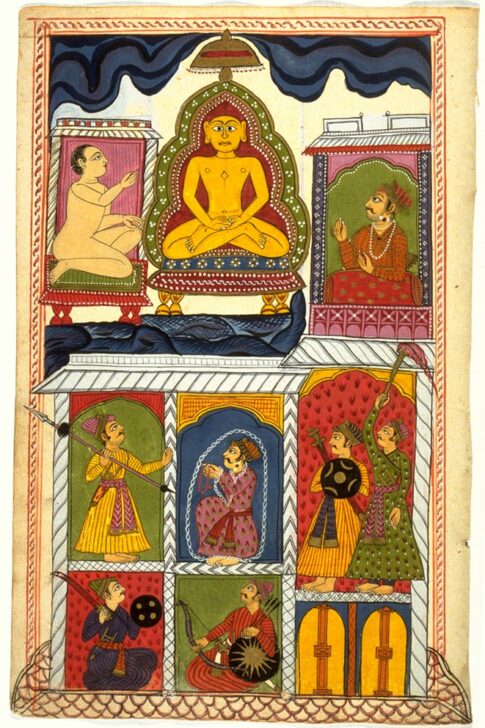Digambara Jain manuscript page: Jina venerated by a monk, raja, and warriors
Artist Unknown, India, Rajasthan, Sirohi School

Description
Gallery Rotations Fall 2012
Tirthankara and monk from Digambara Jain manuscript
India, Sirohi School
18th century
Ink, opaque watercolor, and gold on paper
Gift of Dr. and Mrs. Leo S. Figiel and Dr. and Mrs. Steven J. Figiel, 1975/2.178
Jina venerated by a monk, raja, and warriors from Digambara Jain manuscript
India, Sirohi School
18th century
Ink, opaque watercolor, and gold on paper
Gift of Dr. and Mrs. Leo S. Figiel and Dr. and Mrs. Steven J. Figiel, 1975/2.179
Jina and worshippers from Digambara Jain manuscript
India, Sirohi School
18th century
Ink, opaque watercolor, and gold on paper
Gift of Dr. and Mrs. Leo S. Figiel and Dr. and Mrs. Steven J. Figiel, 1975/2.180
In the Jain religion, book production reflects the integral relationship among the laity, monastic community, and the Jina, or enlightened Jain teacher. The dedication of sacred books for shrines is required of devotees, and while commissioning a book fulfills the lay obligation of charity, beholding a book helps the individual achieve the proper mental state for spiritual guidance. It was customary for a lay donor to commission a copy of a text for presentation to his spiritual teacher and ultimately to the temple library. Over the centuries, monastic libraries received great quantities of texts, which were employed in the instruction of monks and nuns, who were themselves discouraged from practicing the art of painting: one text expressly warns of the power of painting to arouse sensual feelings. In these colorful pages, both the golden-hued Jina seated on a simple throne and the monk who venerates him are naked, identifying them as Digambara (sky-clad) Jina.
Subject Matter:
The stark picture reflects essential features of the Jain faith: the ideal of renunciation, meditation on the Jina, and reliance on canonical texts. Dedication of sacred books is required of Jain devotees, and book production reflects the integral relationship between the laity, monastic community, and the Jina. Commissioning a book fulfills the lay obligation of charity, while beholding a book helps the individual achieve the proper mental state for spiritual guidance.
It was customary for a lay donor to commission a copy of a text for presentation to his spiritual teacher and ultimately to the monk’s temple library. Over the centuries, libraries received great quantities of texts, which were employed in the instruction of monks and nuns. Monks and nuns were discouraged, however, from practicing the art of painting: one text expressly warns them of the power of painting to arouse sensual feelings.
Physical Description:
The image is divided in to two main halves.
The top half is divided in 3, and the bottom half divided in 6. All the divided spaces, except for the lower right corner contain a human figure. In the top half the two outer figures face inward toward the central figure who is seated on a panel slightly above them. The central figure is yellow, with out clothing, on a red background outlined with an olive green border. The figure to the left is cream colored without clothing on a pinkish background. While the figure to the right is clothed in red on a green background.
The figures in the lower half carry shields and various weapons. The dominate colors in each of the 6 sections rotates between green, blue, red and yellow.
Usage Rights:
If you are interested in using an image for a publication, please visit https://umma.umich.edu/request-image/ for more information and to fill out the online Image Rights and Reproductions Request Form.